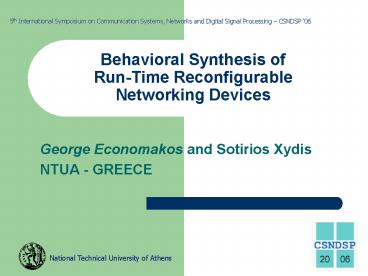Behavioral Synthesis of RunTime Reconfigurable Networking Devices - PowerPoint PPT Presentation
1 / 20
Title:
Behavioral Synthesis of RunTime Reconfigurable Networking Devices
Description:
... has relative small arithmetic blocks that can be reconfigured very fast. When an arithmetic block is idle it can be reconfigured in some other needed type ... – PowerPoint PPT presentation
Number of Views:45
Avg rating:3.0/5.0
Title: Behavioral Synthesis of RunTime Reconfigurable Networking Devices
1
Behavioral Synthesis of Run-Time
ReconfigurableNetworking Devices
5th International Symposium on Communication
Systems, Networks and Digital Signal Processing
CSNDSP 06
- George Economakos and Sotirios Xydis
- NTUA - GREECE
National Technical University of Athens
2
Outline
- Key ideas
- Motivation
- Other approaches
- Introductory material
- Proposed methodology
- Experimental results
- Implementation issues
- Conclusion
3
Key ideas
- Hardware
- Optimized area
- High speed
- Low flexibility
- Software
- Large area
- Moderate speed
- Very high flexibility
Reconfigurable Hardware Optimized area, High
speed, High flexibility
4
Key ideas
- Field Programmable Gate Arrays (FPGAs)
- Contain an array of computational elements whose
functionality is determined through multiple
programmable configuration bits - These elements are connected using a set of
routing resources that are also programmable
5
Key ideas
The most common configuration technique is to use
Look-Up Tables (LUTs) implemented with RAM
6
Key ideas
- Frequently the areas of a program that can be
accelerated through the use of reconfigurable
hardware are too numerous or complex to be loaded
simultaneously onto the available hardware. For
these cases it is beneficial to be able to swap
different configurations in and out of the
reconfigurable hardware as they are needed.
7
Key Ideas
Run-Time Reconfiguration (RTR) supports the
concept of Virtual Hardware
8
Key ideas
- FPGAs require less manufacturing and testing time
- Modern FPGAs are very powerful
- Modern design techniques seek to minimize design
time as well - As a consequence, FPGA based consumer electronics
hit the market earlier without performance cost - High-Level Synthesis (HLS) transforms algorithms
into structures and provide fast design space
exploration - In communication and networking applications,
with complicated control paths, HLS supports
speculative execution to achieve better throughput
9
Key ideas
10
Motivation
- The architecture HLS generates has relative small
arithmetic blocks that can be reconfigured very
fast - When an arithmetic block is idle it can be
reconfigured in some other needed type - In Xilinx FPGAs, a LUT based multiplier takes 3-4
times the memory of an adder (of the same bit
width) - In modern architectures reconfiguration time can
be as little as 10ns (and this is going to be
even lower in the near future) - This paper proposes a scheduling heuristic that
utilizes reconfigurable components used as either
1 multiplier or 3 adders and produces shorter
schedules that outperform speed degradation due
to reconfiguration time
11
Other approaces
- In modern devices each LUT may have multiple
configurations (i.e. 8). A hardware context
switch performs RTR. - Conventional devices can be used with the same
idea if we have LUTs to spare. - RTR can be effective if reconfigurations are kept
to a minimum during the whole life time of the
application. - Reconfigurable arithmetic components (using MUXs)
have been proposed as a way to share hardware
resources in non-programmable devices.
12
Introductory material
- 2 , 2 X
- 2 , 1 X, 1 RTR
13
Introductory material
- 1 , 2 X
14
Introductory material
- 1 , 1 X, 1 RTR
15
Proposed methodology
- Resource constrained list scheduling heuristic
16
Proposed methodology
- Modify resource constrained list scheduling
heuristic to - Combine priority lists of operations that can be
executed in a reconfigurable component - When reconfigurable and on-reconfigurable
components are available, the latter take
precedence - Decrease the number of available reconfigurable
components in a control step only when they are
fully covered
17
Proposed methodology
- For complicated control flows (like network
protocols) - Isolate code blocks with exact one entry and one
exit point (basic blocks). - Find the shortest schedule for each basic block
and for all possible reconfigurations. - Combine the schedules of each block adding
reconfiguration control step when required.
18
Experimental Results
19
Implementation issues
- Use an embedded processor for RTR
- A slice of the FPGA is written in memory, small
modifications are applied (to make 1 multiplier 3
adders) and put back in configuration memory
20
Conclusion
- RTR can fit large algorithms into small chips.
- HLS can be combined with RTR and provide faster
implementations (even 50). - As reconfiguration time is continuously
decreasing, this technique may be proven very
effective.































